In a lion's clothes
Images and stories about the Senegalese lion dance tradition
Etnosoi! festival, Malmitalo 8-26 November 2022
Malmitalo opening hours:
Mon-Thu 8 am-8 pm
Fri 8 am-6 pm
Sat 10 am-4 pm
Sun closed
This exhibition takes the viewer to Dakar, capital of Senegal, where the local lion dance, known as simb, is highly popular, especially among children, although this colourful tradition attracts adults as well.
Lion dance performances combine music, dance and theatre, as well as spectacular costumes and face-painting into a partially pre-rehearsed, partially improvised performance event, in which the audience also plays its own role. Sometimes the performances include dangerous stunts such as fire eating, dancing on glass shards or walking on hot coals. However, the main focus is always on dance and the accompanying rhythms and songs.
The exhibition includes documentary materials of lion dance performances and their preparations, and of course of the dancers and the musicians who accompany them, photographed and filmed by Karoliina Halsti-Ndiaye and Elina Seye. The exhibition also includes textile works inspired by the costumes and face-paintings of the lion dancers by Halsti-Ndiaye.
Pictures in the exhibition
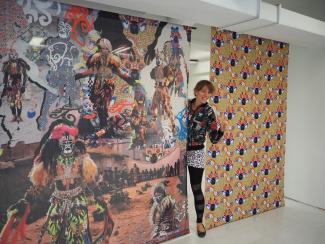
The large collage and printed fabrics combine lion dancers’ figures, colours and patterns with social media symbols. Through social media, the lion dance tradition has gained a new positive visibility. Possibly as a result, the performers’ costumes and face-paintings have become more elaborate and colourful.
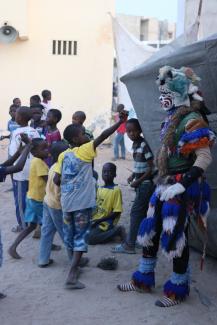
To watch a simb performance, you have to buy a ticket that usually costs 100–300 cfa (about 20–50 cents in euro). If the lions find a person without a ticket, they will order the ticketless spectator into the middle of the crowd and wet his clothes, pour sand on him or order him to do push-ups, for example, and may even hit him.
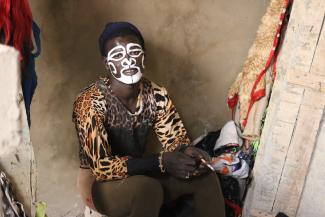
Preparations for the performance take place in a closed space accessible only to members of the performing group. It can take an hour or more for the lions to put on their costumes and paint their faces.
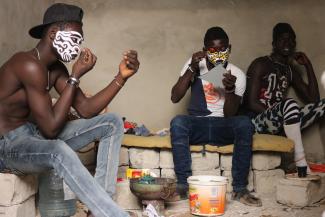
Face-painting aims to blur the human figure of the performer’s face but often does not imitate the features of a real lion. Colours are chosen to match the colours of the performer’s costume. The paints used are oil-based paints sold at building supply stores.
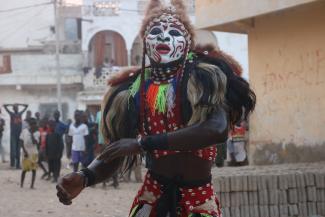
Colourful and decorative face paintings are a relatively new phenomenon: in the past, only natural colours, such as coal, chalk and red clay, were used for painting. Today, even neon colours and glitter can be seen in costumes and face-paintings.

The performers make their own costumes and accessories. In the past, the lions’ costumes were simpler, and performers oiled the skin left visible to make it shiny. Today, many lion dancers wear slim-fitting shirts and pants under the actual costume.
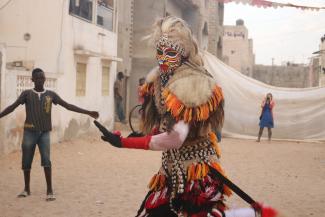
Lion costumes are usually made of animal print fabrics or faux fur and add fringes to the borders of the fabrics. In addition to the fringe, the lions’ headdresses and shoulder decorations may use cowhair or horsehair to create a lion-like mane around the performer’s face.
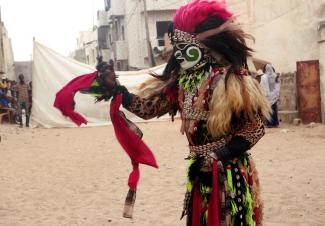
The costumes and headdresses are decorated with white cowry shells, which are said to have once served as money. The lions also wear around their waists leather strips that are said to give the wearer special powers or to protect against evil spirits and the evil intentions of others.
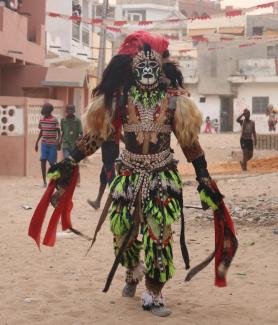
Before the performance, some of the performers roam the nearby streets to attract people to their simb. The sound of the sabar drums and the amplified songs echoing from the performance area also call people in the neighborhood to attend the event.
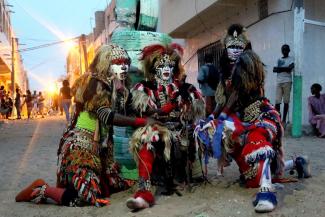
Simb performances may be organised by local associations, which raise money for themselves through the performances, but sometimes also the simb groups themselves organise them. Some groups are very active and rehearse together on a regular basis, while others work only occasionally and the members of the group change from performance to performance.
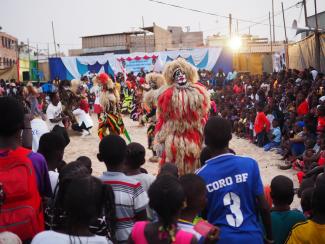
The big lion, the leader of the group, may have a costume made entirely of animal hair. This role is usually given to the most experienced performer in the group. Other characters besides the lions may also be seen in performances.
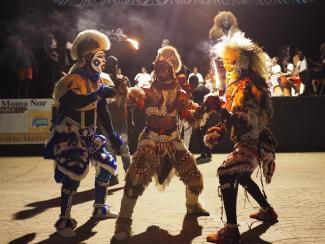
In the beginning of the performance, the lions wander back and forth, sometimes going out into the street and then returning, some looking for ticketless spectators in the audience, others dancing small solos or entertaining the audience with stunts such as fire-eating.
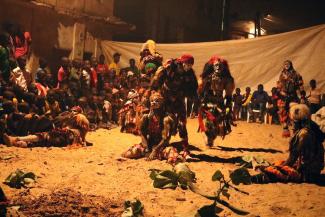
When all the lions are finally in front of the audience, the whole group dances together. In between the joint choreography, more improvised sections such as dance solos and acrobatic tricks continue.
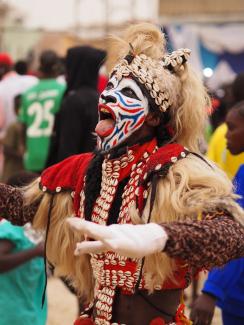
In simb performances, the lions never speak, and they communicate with the audience only through gestures. In their attempt to embody a lion, the dancers, for example, drink water as the animals do, from a washbasin in the middle of the performance area. Wild facial expressions are also part of the act.
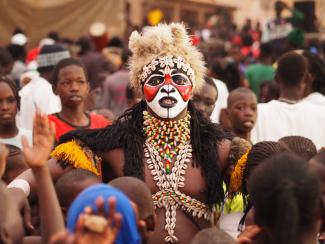
It is said that the first lion dancers were people who had been bitten by a real lion and were possessed by the spirit of the lion. One could escape the clutches of such a human lion by reciting a spell (jat). Today, the spells are performed by the singers of the band accompanying the simb performance, who also give instructions to the lions in their songs.
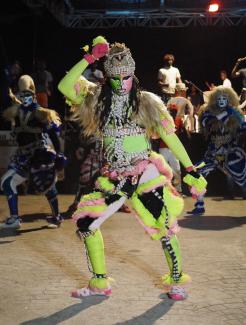
Today, many simb performers are well-known dancers. Older people recall that in the past, lions did not dance but concentrated on scaring the audience. Drumming was still part of the show, and the audience was allowed to dance for the lions.
Documentary film
The documentary film In a Lion's Clothes, which is shown as part of the exhibition, takes the viewer into the atmosphere of Dakar’s lion dance performances. In the film, the performers of a younger generation discuss the history of the simb tradition and the meanings of simb performances in today's Senegal.
Film duration: 30 min.
Languages: Wolof/French, subtitles: English and Finnish (alternately)
Filmed in Dakar, Senegal, 2015-16
Finland/Senegal, 2022
Groups appearing in the documentary and photos:
Afrika Akay Degg (Camberene, Dakar)
Groupe Diamm (Yoff, Dakar)
Keur Gui Simb (Medina, Dakar)
Production, cinematography, interviews and translations: Elina Seye, Karoliina Halsti-Ndiaye
Film editing: Elina Seye
Photographs: Karoliina Halsti-Ndiaye, Elina Seye
Image processing, collage work, textile art: Karoliina Halsti-Ndiaye
Supported by the Niilo Helander Foundation and the Academy of Finland
